Designers talk about empathy. A lot. But do you really know what they mean? Social psychologist Daniel Batson identifies eight different ways that people use the word “empathy,” creating more than enough opportunity for misunderstanding. For example, a recent article by another psychologist, Paul Bloom, The Case Against Empathy, frames empathy as mutually exclusive with reason, and suggests that it is analogous to feeling sorry for someone. This statement produced a number of rebuttal articles and online reactions as a misrepresentation and oversimplification.
As important as empathy is to user experience, there is no model through which we can better understand or explain what empathy is. Instead, we have countless hours of people talking past each other. Let me see if I can help.
What Is Empathy?
Empathy can be defined as an explanatory principle for our ability to experience a phenomenon of feeling as if we are embodying or understanding someone else’s experience and the related meanings from the context and vantage point of that “other.”
I didn’t define the word to claim authority over it, but a good definition can minimize misunderstandings. The word has its roots in the German word Einfühlung, coined by philosopher Robert Vischer to explain an experience he had during which he felt as though he had embodied a piece of artwork, so much so that he felt as though he was “one” with it.
The word was later imported to the United States and translated into English by Edward Titchener in 1909. As a psychologist, Titchener used the word to explain how we can experience other people. However, empathy is not limited to other humans. We can empathize with animals or plants. Most of us can empathize with characters in novels. The best computer programmers empathize with the computer—a phenomenon popularly known as “grokking.” What determines whether we can empathize is how we subjectively perceive the “other.”

It is useful to separate “empathy” as a potential, and “empathizing” as an event (see Figures 1 and 2). Otherwise, we get into situations where people say that “you have to feel empathy for her,” which more often than not confuses people by sounding similar to “feel sympathy for.” The very phrase “feel empathy” is also often used by people who wish to say that they were so affected by someone else’s emotion that they lost their “self.” That’s emotional contagion: a related but distinct phenomenon that may help us empathize. In short, using the word “empathy” as both a potential and a feeling can cause confusion and misunderstanding.
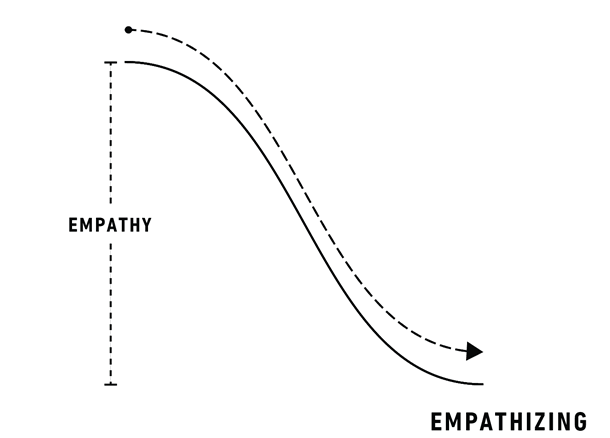
The best metaphor for empathizing I’ve been able to come up with is the concept of “metaphor” itself. In other words, when we empathize, we create a metaphor between ourselves and others, while being fully cognizant of the limitation of the metaphor.
How Does Empathy Realize?
Let’s take a closer look at the diagram in Figure 3. Point A is the event of “not empathizing,” point B is the event of “empathizing,” and “empathy” is the potential that, when realized, can empower us to travel from point A to point B. So let’s label the journey of going from one point to another as “realizing empathy.”
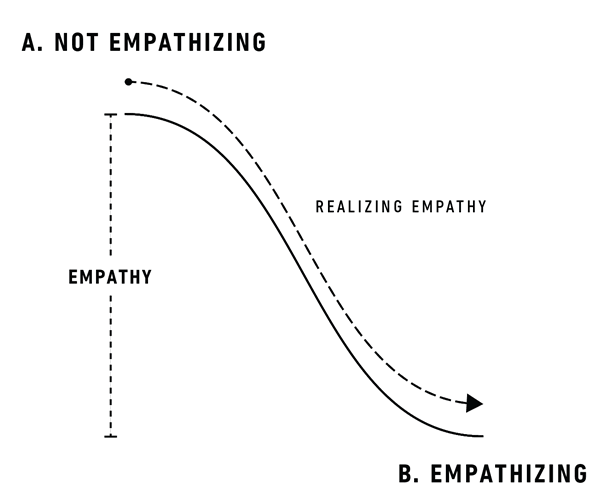
There are two ways empathy can be realized. First, it can be involuntary, almost as a reflex, requiring no conscious effort, like a ball pushed down a hill. Think of a friend you’ve known for a long time. Think of a time when, without her saying a single word, you were able to tell precisely what she was thinking, feeling, wanting, or needing. Maybe you finished her sentences or said exactly the thing that she needed to hear when she needed to hear it. These are all situations in which your empathy was triggered to realize almost automatically.
But that’s not the only way to realize empathy. Another way is for you to realize it voluntarily, as part of a deliberate process, requiring conscious effort, like pushing a ball up a hill (see Figure 4). Imagine yourself encountering someone you are not familiar with or find suspicious; someone who says things that you disagree with, or whose words you find difficult to understand. How would you feel? Threatened? Awkward? Confused? Frustrated? Uncomfortable? If yes, this is a situation in which your empathy will not realize until you make an effort.

It is useful to distinguish these two paths to empathy to draw attention to the second, deliberate process. Understanding why realizing empathy requires effort will be the key to developing your own empathy. There are three high-level requirements for deliberately realizing empathy:
- Awareness: Becoming aware that your empathy is not realizing in the specific moment.
- Care: Having the willingness or the desire to put in the effort to realize your empathy in the specific moment.
- Ability: Developing the sensitivity, skills, and knowledge required to realize your empathy in the specific moment.
The awareness factor is of special interest because it is often the least obvious. We have several mechanisms by which we can reframe a situation into one that is more favorable to our own biases. One mechanism for doing so is labeling. For example, if we label those we disagree with as evil or stupid, we can justify not caring enough to empathize with them. Or, if we blame someone for wearing the “wrong” kind of clothes, that can help justify our prejudice against them. These are situations that can be reframed as paradoxes, arising from our inability to resolve the conflict between two differing points of view, or between our expectations and the reality of a situation (see Figure 5).
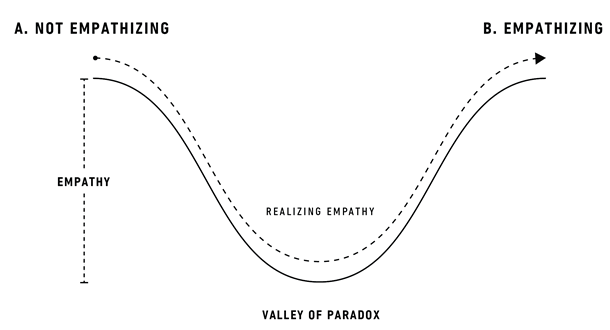
How Can a Designer Facilitate Empathy?
Deliberately realizing empathy can be difficult, so, as designers, we should ask ourselves, “How can we make it easier for others to realize their empathy?” To help others, we have to first understand what makes it difficult.
Contrary to popular belief, empathy is not something we either have or lack. For each and every one of us, there will always be moments when we will be unable to realize our empathy because of the specific relationships that are at play. This is why I call empathy a “relational potential” as opposed to merely a “potential.”
As shown in Figure 6, we can talk about empathy in terms of:
- Space: The quality of the relationship with another person.
- Attitude: How we are predisposed to react to our thoughts and other people.
- Language: The stimuli that interact with our attitude to trigger our reactions.
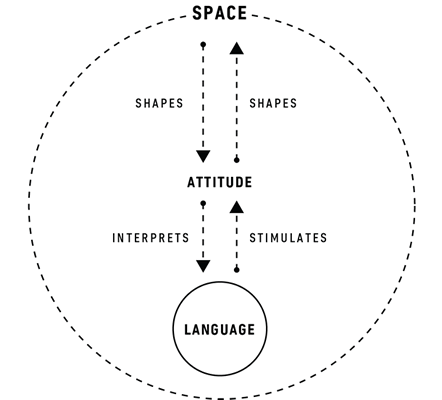
It’s useful to think of the relationship dynamics in terms of two stages: first impression and ongoing impression.
The first impression is similar to going on a date for the first time. Perhaps for some reason, the space you occupy with the other person affects your attitude in such a way that you feel as if you can’t “be yourself.” As a result, you are self-conscious and the conversation feels meaningless and superficial. It’s not a very intimate relationship. On top of that, perhaps you also feel a bit intimidated or feel the need to defend yourself. Consequently, you can’t really enjoy yourself. In a relationship like this you don’t feel empowered to play. In other words, it doesn’t feel very dynamic and you have difficulty even caring enough to try to empathize.
When you are designing, you want to proactively create a space in which your product or service feels sufficiently intimate and dynamic to be appealing enough for a second date (see Figure 7).
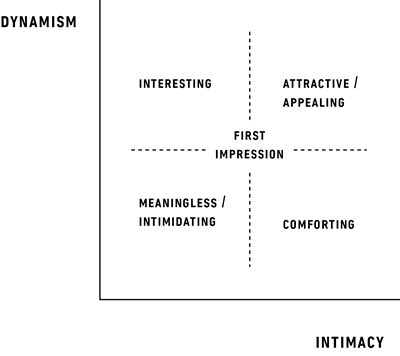
Now let’s say you came back from your date and reflect on it. Yes, it was meaningless and intimidating, but you think maybe you should give him a second chance. Why? Because you’ve been on dates where others have gotten the wrong first impression of you. In other words, in an effort to try and empathize with him, you give him the benefit of the doubt.
The next week rolls around and you go on a second date. You enter the restaurant and sit across a table. You look at his face and you can feel that something has changed. To your surprise, he starts to apologize. He says he is sorry that he projected himself a certain way on the previous date. He tells you how nervous he was to be on a first date with you, how much pressure he felt trying to impress you, and how foolish he feels to have behaved the way he did.
His words affect you, and you feel your attitude toward him change enough that you feel comfortable opening up to him. You tell him that you felt the same way and were also projecting yourself a certain way so as not to lose your ground. He smiles. You smile back. You both start laughing about the absurdity of the situation, you connect, you empathize.
The conversation that takes place from there on has a distinctly different quality—it is an empathic conversation. You both respect each other’s differing thoughts. Without trying to win or one-up each other, you listen to each other with a sense of presence. You consider the language you use to express your thoughts, yet they are acts of spontaneity as well as honesty and sincerity. The space now feels both meaningful and creative (see Figure 8).
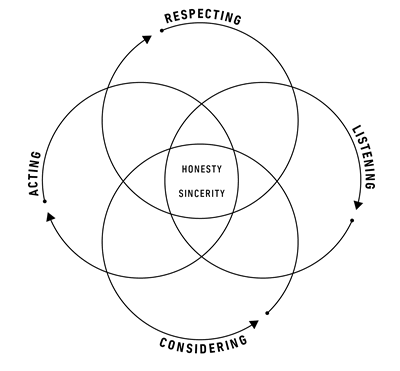
Design as Multi-dimensional Empathic Conversation
Your product or service has to create a space that allows empathic conversations to develop within the interaction so that users can experience the space as both meaningful and creative. As this quality is experienced across time, with integrity, the users’ level of trust in you and your product or service will also start to develop (see Figure 9).

Empathy is relevant to any and all relationships we can have at any time, whether the relationship is between us and our clients, teammates, materials, tools, friends, family, or even our own “selves.” We can never have a full understanding of any of them, so realizing empathy in relation to all of them is a lifelong pursuit.
May empathy be with you.“同理心/移情”对用户体验来说意味着什么呢?是指我们从他人的角度理解其体验的能力,这对任何设计师来说都是一种宝贵的技能。
我们有时会经历这样一种现象,即感觉自己好像在体现或了解他人的体验。同理心/移情能够解释我们在这方面的能力。同理心/移情可能是经过深思熟虑后得到的结果,要求有意识的努力。这种意识、关注力和能力可以帮助我们开发更有意义、更有创意的产品。
文章全文为英文版사용자 경험에서 공감이란 무엇을 의미할까요? 다른 사람의 관점에서 그들의 경험을 이해하는 것은 우리의 능력으로써 모든 디자이너에게 중요한 기술입니다.
공감은 다른 사람의 경험을 본인이 구현 또는 이해하는 것과 같은 방식으로 설명하는 것입니다. 공감은 의식적 노력이 필요한 인위적 과정의 결과가 될 수도 있습니다. 인식, 배려, 능력에 대한 노력은 더 의미 있고 독창적인 느낌의 제품을 만드는 데 기여합니다.
전체 기사는 영어로만 제공됩니다.O que significa empatia na experiência do usuário? É nossa capacidade de entender a experiência de outra pessoa a partir do seu ponto de vista – uma habilidade valiosa para qualquer designer.
Empatia é uma forma de explicar nossa capacidade de experimentar o fenômeno de sentir como se estivéssemos incorporando ou compreendendo a experiência de outra pessoa. A empatia pode resultar de um processo deliberado, exigindo um esforço consciente. A conscientização, o cuidado e a habilidade que ela exige fazem a diferença ao nos ajudar a criar produtos que parecem mais significativos e criativos.
O artigo completo está disponível somente em inglês.ユーザーエクスぺリアンスにおいて感情移入とは何を意味するのか?感情移入とは、他者の経験をその人の視点で理解する能力のことである。
感情移入とは、あたかも他者の経験を具体化または理解しているかのように、私たちが持っている感情現象の経験能力を説明する方法である。感情移入は、意識的な努力を要する意図的なプロセスの結果と言える。それに必要な認識、配慮、能力は、より有意義で創造的だと感じられる製品の作成努力を下支えする効力を持つ。
原文は英語だけになります¿Qué significa la empatía para la experiencia de usuario? Es nuestra capacidad de entender la experiencia de otro desde su perspectiva: una habilidad valiosa para cualquier diseñador.
La empatía es una manera de explicar nuestra capacidad de experimentar el fenómeno de sentirnos como si estuviéramos encarnando o entendiendo la experiencia de otra persona.
La empatía puede ser el resultado de un proceso deliberado que requiere un esfuerzo consciente. La conciencia, la atención y la capacidad que esto conlleva dan sus frutos al ayudarnos a crear productos que se sienten más significativos y creativos.
La versión completa de este artículo está sólo disponible en inglés.
